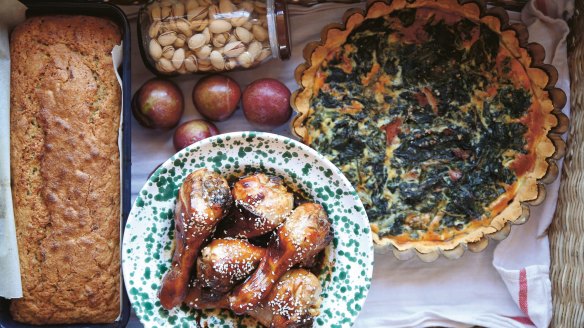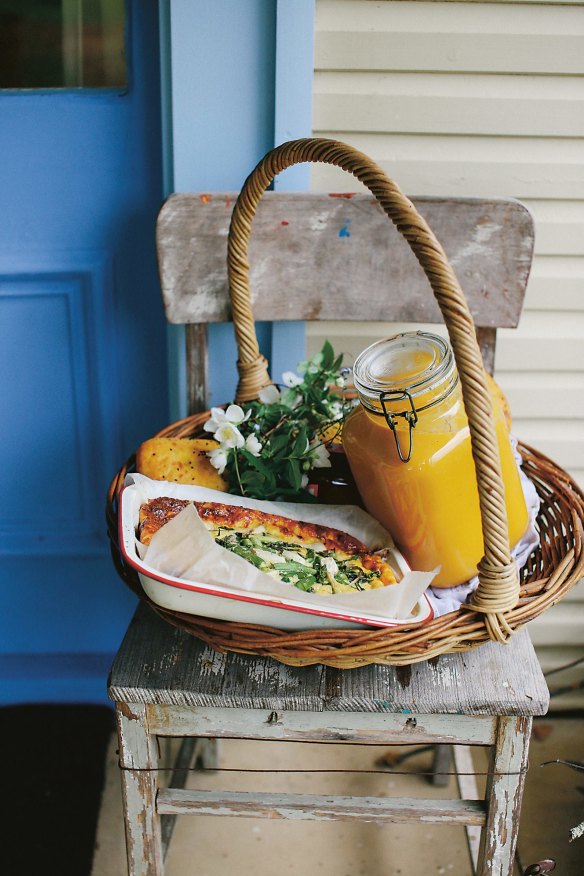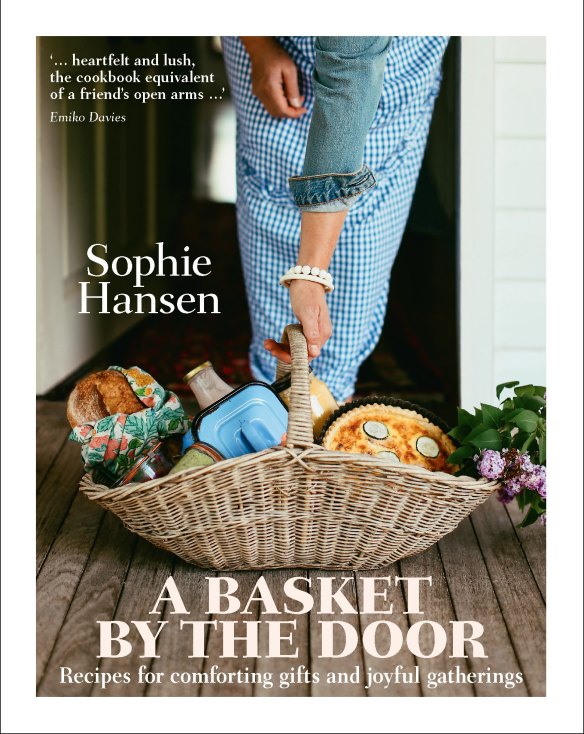How to ace care packages: delivering food for family and friends in need

Giving food to friends in need delivers more than a meal, it connects individuals, which is what we need right now.
Is it a thing of the past to bring a homemade casserole or pot of chicken soup to a friend who is sick, grieving or simply snowed under? A phone conversation with a sick faraway friend had me wondering. To me, bringing food is a practical thing to do when the right words – if you can find them – aren't enough. But for my friend, many of those closer to home weren't really "delivering".
Such deliveries are an area of expertise for food writer Sophie Hansen, whose book A Basket by the Door is a how-to for creating delicious, nourishing care packages – from simple snacks to sturdy picnic-friendly cakes and hearty meals, ordered by season and situation (smoko snacks, road trip salads, new mum pick-me-ups).
"Cooking for another is the most thoughtful act of all," Hansen says. Although it wasn't until relocating from Sydney to country NSW that she fully appreciated what such a gesture can mean for an individual or a community.
"Where we live, as soon as something happens, people automatically bring food," Hansen says, recalling when fires threatened the farms in her area – about an hour and a half outside of Orange. A call-out from the local Country Women's Association brought such a flash flood of meal deliveries that the Rural Fire Service had to rent two cool rooms to store it all, before politely suggesting no further food was needed.
But what about people who don't live in a close-knit community with a local CWA branch to send out a home cook and bakers' "bat signal"? In cities and suburbs it can be a little less obvious – or we're too busy to notice – when the need is there, what food might be appropriate, or when there's too little or too much. In times of crisis or joyful upheaval (new baby or moving house), it can seem like there's no good time to show up or call to ask what might help.
It's helpful to stop and think, 'Who is this for? Where are they at? And what would I feel like if I was here?'Sophie Hansen
For some, church groups, parents' groups or workplaces might be a space within which people are aware of and respond to someone's needs for food or other assistance, but for many, no such network exists.
According to psychologist Susan Pinker, social isolation is up there with infectious disease as the public health risk of our time. In her book The Village Effect, Pinker cites studies (and a visit to a small Sardinian village with an inordinate number of centenarians) to back up her argument that in leaving the "literal village" for the "virtual village", we're living shorter, unhappier lives.
"Face-to-face contact releases neurotransmitters that foster trust, reduce stress, kill pain and induce pleasure," Pinker says, adding that a simple act like making eye contact can be enough to generate dopamine and release oxytocin, which lowers cortisol/stress levels. Similar results were found in studies looking at the act of sharing food.

Sophie Hansen, through responses to A Basket by the Door and her blog Local is Lovely, has a growing file of anecdotal evidence supporting the theory that sharing food with others prompts feel-good vibes for both the giver and receiver. "Even the simplest things, people remember," Hansen says, citing the time a friend who'd just finished cancer treatment came home to find a basket of food that included ice-cold mineral water – it hit the spot perfectly and was remembered fondly.
It's also the type of thing that people are motivated to pay forward. Once someone has experienced how helpful and meaningful "a basket by the door" is, they're much more likely to do it for someone else. "It takes just one person doing it for you," Hansen says.
Asked what might put people off cooking for others, Hansen suggests some may be intimidated (competitive cooking shows can set up a subconscious worry that our food may be judged harshly), or perhaps don't know where to start. "It's helpful to stop and think, 'Who is this for? Where are they at? And what would I feel like if I was here?' And remember that it's OK to take baby steps and start with something simple, perhaps dips, some nice cheese, chopped up vegies and pickles."

Another deterrent can be concerns about dietary requirements, preferences and even that the person might already be overwhelmed with deliveries. One solution is creating a roster between mutual family and friends. Take Them a Meal , a free online tool, allows users to do exactly this, meaning all the information regarding diet and timing is in one easily accessible place without need for a whole lot of admin. Co-founder of Take Them a Meal, Adina Bailey, says more than half a million people use the site each month.
"We are connected through our times of joy and grief and when we cook for another person we are acknowledging that those times are significant and that we need to support one another," Bailey says. She believes people are no less willing to help each other in this way now than they were in previous generations, and that technology such as takethemameal.com simply facilities the process, and also reduces waste and miscommunications.
While real life interactions seem to be the ideal, there is undoubtedly capacity within online communities for the "village effect" to mobilise, and for the development of social capital (very simply, networks of relationships, shared values, co-operation and reciprocity within society).
Jo Whitton is the wholefood cook behind the Quirky Cooking blog. Whitton's work creating recipes for people with food allergies and intolerances has attracted a large fan-base, including close to 300,000 Facebook followers. A spin-off group, Quirky Healthy Hampers, connects people looking for someone to cook for a family member or friend (usually someone with an illness and/or strict dietary requirements) with volunteers.
The Quirky community was where I looked for someone who might provide for my far-away friend. The response was swift and heartfelt – multiple people volunteered, and within a few days, someone close by delivered a no-strings-attached pre-portioned cargo of homemade chicken soup, beef stroganoff and mushroom risotto.
It moved me that someone would act so generously towards a person they'd never met, and also convinced me that there's a place where "virtual village" and "literal village" can combine to make a strong and wonderfully supportive community.
How to ace care packages
- Cook in double batches: one for your friend, one for you.
- Make things that can be frozen and reheated easily and safely.
- Package food securely and keep cool or hot as necessary (and don't assume you'll get your containers or dishes back).
- Keep it simple – don't stress yourself out by cooking beyond your capabilities.
- Consider meal delivery services – if you can't do it, recruit! (Perhaps, dinnerladies.com.au, dinneronthetable.com.au, or twogood.com.au)
- Start a roster if there's a surplus of cooks (see takethemameal.com).
- Leave your care package by the door if face-to-face contact is not appropriate. Use commonsense and be considerate.
A Basket by the Door: Recipes for Comforting Gifts and Joyful Gatherings by Sophie Hansen, Murdoch Books, $39.99. Hansen's next book, In Good Company, will be out on April 1, 2021.
Appears in these collections
The best recipes from Australia's leading chefs straight to your inbox.
Sign up